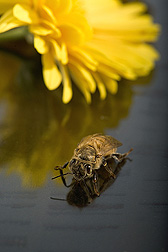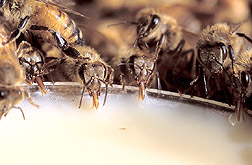Colony Collapse Disorder
| Questions and Answers: Colony Collapse Disorder |
 |
Beginning in October 2006, some beekeepers began reporting losses of 30-90 percent of their hives. While colony losses are not unexpected during winter weather, the magnitude of loss suffered by some beekeepers was highly unusual. This phenomenon, which currently does not have a recognizable underlying cause, has been termed "Colony Collapse Disorder" (CCD). The main symptom of CCD is simply no or a low number of adult honey bees present but with a live queen and no dead honey bees in the hive. Often there is still honey in the hive, and immature bees (brood) are present. ARS scientists and others are in the process of carrying out research to discover the cause(s) of CCD and develop ways for beekeepers to respond to the problem.
Why should the public care about honey bees? Bee pollination is responsible for $15 billion in added crop value, particularly for specialty crops such as almonds and other nuts, berries, fruits, and vegetables. About one mouthful in three in the diet directly or indirectly benefits from honey bee pollination. While there are native pollinators (honey bees came from the Old World with European colonists), honey bees are more prolific and the easiest to manage for the large scale pollination that U.S. agriculture requires. In California, the almond crop alone uses 1.3 million colonies of bees, approximately one half of all honey bees in the United States, and this need is projected to grow to 1.5 million colonies by 2010.
Honey bee colony health has also been declining since the 1980s with the advent of new pathogens and pests. The spread into the United States of varroa and tracheal mites, in particular, created major new stresses on honey bees.
Is there currently a crisis in food production because of CCD? While CCD has created a very serious problem for beekeepers and could threaten the pollination industry if it becomes more widespread, fortunately there were enough bees to supply all the needed pollination this past spring. But we cannot wait to see if CCD becomes an agricultural crisis to do the needed research into the cause and treatment for CCD. The cost of hives for pollination has risen this year. But much of that is due to growing demand. Some of the price increase may also be due to higher cost of gas and diesel and other increases related to energy and labor costs. Commercial beekeepers truck hives long distances to provide pollination services, so in particular they must deal with rising expenses.
Are there any theories about what may be causing CCD? Case studies and questionnaires related to management practices and environmental factors have identified a few common factors shared by those beekeepers experiencing CCD, but no common environmental agents or chemicals stand out as causative. There are three major possibilities that are being looked into by researchers. Pesticides may be having unexpected negative effects on honey bees. A new parasite or pathogen may be attacking honey bees. One possible candidate being looked at is a pathogenic gut microbe called Nosema. Viruses are also suspected. A perfect storm of existing stresses may have unexpectedly weakened colonies leading to collapse. Stress, in general, compromises the immune system of bees (and other social insects) and may disrupt their social system, making colonies more susceptible to disease. These stresses could include high levels of infection by the varroa mite (a parasite that feeds on bee blood and transmits bee viruses); poor nutrition due to apiary overcrowding, pollination of crops with low nutritional value, or pollen or nectar scarcity; and exposure to limited or contaminated water supplies. Migratory stress brought about by increased needs for pollination might also be a contributing factor.
Has CCD ever happened before? The scientific literature has several mentions of honey bee disappearances—in the 1880s, the 1920s and the 1960s. While the descriptions sound similar to CCD, there is no way to know for sure if the problems were caused by the same agents as today's CCD. There have also been unusual colony losses before. In 1903, in the Cache Valley in Utah, 2000 colonies were lost to an unknown "disappearing disease" after a "hard winter and a cold spring." More recently, in 1995-96, Pennsylvania beekeepers lost 53 percent of their colonies without a specific identifiable cause.
What about cell phones—do they have anything to do with CCD? The short answer is no. There was a very small study done in Germany that looked at whether a particular type of base station for cordless phones could affect honey bee homing systems. But, despite all the attention that this study has received, it has nothing to do with CCD. Stefan Kimmel, the researcher who conducted the study and wrote the paper, recently e-mailed The Associated Press to say that there is "no link between our tiny little study and the CCD-phenomenon ... anything else said or written is a lie."
What is ARS doing about CCD? In April 2007, ARS held a Colony Collapse Disorder Research Workshop that brought together over 80 of the major bee scientists, industry representatives, extension agents, and others to discuss a research agenda. They identified areas where more information is needed and the highest-priority needs for additional research projects related to CCD. A CCD Steering Committee, led by ARS and USDA's Cooperative State Research, Education, and Extension Service, developed a Research Action Plan to coordinate a comprehensive response for discovering what factors may be causing CCD and what actions need to be taken. One of the tools that will help in this research is the recently sequenced honey bee genome to better understand bees' basic biology and breed better bees, and to better diagnose bee pests and pathogens and their impacts on bee health and colony collapse. The use of this genome information certainly will have great applications in improving honey bee breeding and management. The search for factors that are involved in CCD is focusing on four areas: pathogens, parasites, environmental stresses, and bee management stresses such as poor nutrition. It is unlikely that a single factor is the cause of CCD; it is more likely that there is a complex of different components. In September 2007, a research team that included ARS published the results of an intensive genetic screening of CCD-affected honey bee colonies and non-CCD-affected hives. The only pathogen found in almost all samples from honey bee colonies with CCD, but not in non-CCD colonies, was the Israeli acute paralysis virus (IAPV), a dicistrovirus that can be transmitted by the varroa mite. It was found in 96.1 percent of the CCD-bee samples. This research does not identify IAPV as the cause of CCD. What this research found was strictly a strong correlation of the appearance of IAPV and CCD together. No cause-and-effect connection can be inferred from the genetic screening data. (More information about this study)
This was the first report of IAPV in the United States. IAPV was initially identified in honey bee colonies in Israel in 2002, where the honey bees exhibited unusual behavior, such as twitching wings outside the hive and a loss of worker bee populations. The study also found IAPV in honey bees from Australia that had been imported into the United States, as well as in royal jelly imported from China. Australian bees began to be imported from Australia into the United States in 2005. Questions were raised about a connection between those imported bees and the appearance of IAPV in the United States. Beekeepers sought out Australian imports of bees as a way to replenish their hive populations. To determine whether IAPV has been present in the United States since before the importation of honey bees from Australia, a follow up detailed genetic screening of several hundred honey bees that had been collected between 2002 and 2007 from colonies in Maryland, Pennsylvania, California and Israel was conducted by ARS researchers. The results of the follow study showed IAPV has been in this country since at least 2002, which challenges the idea that IAPV is a recent introduction from Australia. (More information about this study) This study in no way rules IAPV out as a factor in CCD. Research by several groups will now focus on understanding differences in virulence across strains of IAPV and on interactions with other stress factors. Even if IAPV proves to be a cause of CCD, there still may also be other contributing factors-which researchers are pursuing.
What should beekeepers do now about CCD? Since little is known about the cause(s) of CCD right now, mitigation must be based on improving general honey bee health and habitat and countering known mortality factors by using best management practices.
What can I as a member of the public do to help honey bees? The best action you can take to benefit honey bees is to not use pesticides indiscriminately, especially not to use pesticides at mid-day when honey bees are most likely to be out foraging for nectar. In addition, you can plant and encourage the planting of good nectar sources such as red clover, foxglove, bee balm, and joe-pye weed. For more information, see www.nappc.org.]
ARS Honey Bee Research
|
Search Library Topics Search Newspaper Columns





